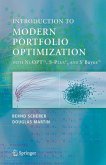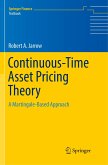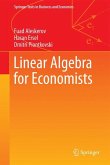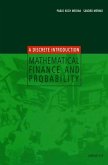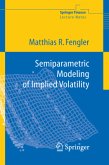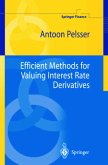This encyclopedic, detailed exposition spans all the steps of one-period allocation from the foundations to the most advanced developments.
Multivariate estimation methods are analyzed in depth, including non-parametric, maximum-likelihood under non-normal hypotheses, shrinkage, robust, and very general Bayesian techniques. Evaluation methods such as stochastic dominance, expected utility, value at risk and coherent measures are thoroughly discussed in a unified setting and applied in a variety of contexts, including prospect theory, total return and benchmark allocation.
Portfolio optimization is presented with emphasis on estimation risk, which is tackled by means of Bayesian, resampling and robust optimization techniques.
All the statistical and mathematical tools, such as copulas, location-dispersion ellipsoids, matrix-variate distributions, cone programming, are introduced from the basics. Comprehension is supported by a large number of figures and examples, as well as real trading and asset management case studies.
At symmys.com the reader will find freely downloadable complementary materials: the Exercise Book; a set of thoroughly documented MATLAB® applications; and the Technical Appendices with all the proofs. More materials and complete reviews can also be found at symmys.com.
Hinweis: Dieser Artikel kann nur an eine deutsche Lieferadresse ausgeliefert werden.
Multivariate estimation methods are analyzed in depth, including non-parametric, maximum-likelihood under non-normal hypotheses, shrinkage, robust, and very general Bayesian techniques. Evaluation methods such as stochastic dominance, expected utility, value at risk and coherent measures are thoroughly discussed in a unified setting and applied in a variety of contexts, including prospect theory, total return and benchmark allocation.
Portfolio optimization is presented with emphasis on estimation risk, which is tackled by means of Bayesian, resampling and robust optimization techniques.
All the statistical and mathematical tools, such as copulas, location-dispersion ellipsoids, matrix-variate distributions, cone programming, are introduced from the basics. Comprehension is supported by a large number of figures and examples, as well as real trading and asset management case studies.
At symmys.com the reader will find freely downloadable complementary materials: the Exercise Book; a set of thoroughly documented MATLAB® applications; and the Technical Appendices with all the proofs. More materials and complete reviews can also be found at symmys.com.
Hinweis: Dieser Artikel kann nur an eine deutsche Lieferadresse ausgeliefert werden.
From the reviews:
This exciting new book takes a fresh look at asset allocation and offers up a masterly account of this important subject. The quantitative emphasis and included MATLAB software make it a must-read for the mathematically oriented investment professional.
Peter Carr, Head of Quantitative Research, Bloomberg LP, Director of Masters in Mathematical Finance program, NYU
Meucci's Risk and Asset Allocation is one of those rare books that takes a completely fresh look at a well-studied problem, optimal financial portfolio allocation based on statistically estimated models of risk and expected return. Designed for graduate students or quantitatively oriented asset managers, Meucci provides a sophisticated and integrated treatment, from investment theory, to optimization methods, to statistical analysis of multi-variate return data, through computational implementation of the results. This is rigorous and relevant!
DarrelDuffie, Professor of Graduate Business School, Stanford University
A wonderful book! Mathematically rigorous and yet practical, heavily illustrated with graphs and worked examples, Attilio Meucci has written a comprehensive treatment of asset allocation starting from statistical concepts, covering investment primitives, and leading to portfolio optimization in a Bayesian context with parameter uncertainty.
Bob Litterman, Head of Quantitative Resources, Goldman Sachs Asset Management
This book takes the reader on a journey through portfolio management starting with the basics and reaching some fascinating terrain. Attilio Meucci shows a real talent for explaining the most difficult of subjects in a very clear manner.
Paul Wilmott, wilmott.com
"This book presents a detailed and well-explained introduction to one-period asset allocation techniques ... . the book gives an impressive and comprehensive introduction to static one-period asset allocation. It explains most of the concepts intuitively and with a minimal mathematical machinery. ... For practitioners, the book serves as a theoretical basis of their actual work. For students of finance and economics it gives a self-contained overview of the main quantitative concepts in the subject." (Ludger Overbeck, SIAM Review, Vol. 48 (3), 2006)
"This book delves into the classical mathematics of portfolio optimization with a few nods to more recent developments in risk measurement such as value-at-risk and copulas. ... For anyone with an interest in the mathematics of portfolio optimization, the book is certainly worth a look. ... The author covers a wealth of statistical and optimization techniques that are worth reading about." (www.riskbook.com, May, 2006)
"The book offers a wide exposition of the main approaches to asset allocation, starting from the classical models up to the recent developments in portfolio management. ... By virtue of the sequential structure of the subjects and the simple but efficacious mathematical treatment, the monograph is useful for graduate students and quantitatively-oriented practitioners too. ... The book is complemented by online resources, consisting of software applications performed by MATLAB ... ." (Emilia Di Lorenzo, Zentralblatt MATH, Vol. 1102 (4), 2007)
This exciting new book takes a fresh look at asset allocation and offers up a masterly account of this important subject. The quantitative emphasis and included MATLAB software make it a must-read for the mathematically oriented investment professional.
Peter Carr, Head of Quantitative Research, Bloomberg LP, Director of Masters in Mathematical Finance program, NYU
Meucci's Risk and Asset Allocation is one of those rare books that takes a completely fresh look at a well-studied problem, optimal financial portfolio allocation based on statistically estimated models of risk and expected return. Designed for graduate students or quantitatively oriented asset managers, Meucci provides a sophisticated and integrated treatment, from investment theory, to optimization methods, to statistical analysis of multi-variate return data, through computational implementation of the results. This is rigorous and relevant!
DarrelDuffie, Professor of Graduate Business School, Stanford University
A wonderful book! Mathematically rigorous and yet practical, heavily illustrated with graphs and worked examples, Attilio Meucci has written a comprehensive treatment of asset allocation starting from statistical concepts, covering investment primitives, and leading to portfolio optimization in a Bayesian context with parameter uncertainty.
Bob Litterman, Head of Quantitative Resources, Goldman Sachs Asset Management
This book takes the reader on a journey through portfolio management starting with the basics and reaching some fascinating terrain. Attilio Meucci shows a real talent for explaining the most difficult of subjects in a very clear manner.
Paul Wilmott, wilmott.com
"This book presents a detailed and well-explained introduction to one-period asset allocation techniques ... . the book gives an impressive and comprehensive introduction to static one-period asset allocation. It explains most of the concepts intuitively and with a minimal mathematical machinery. ... For practitioners, the book serves as a theoretical basis of their actual work. For students of finance and economics it gives a self-contained overview of the main quantitative concepts in the subject." (Ludger Overbeck, SIAM Review, Vol. 48 (3), 2006)
"This book delves into the classical mathematics of portfolio optimization with a few nods to more recent developments in risk measurement such as value-at-risk and copulas. ... For anyone with an interest in the mathematics of portfolio optimization, the book is certainly worth a look. ... The author covers a wealth of statistical and optimization techniques that are worth reading about." (www.riskbook.com, May, 2006)
"The book offers a wide exposition of the main approaches to asset allocation, starting from the classical models up to the recent developments in portfolio management. ... By virtue of the sequential structure of the subjects and the simple but efficacious mathematical treatment, the monograph is useful for graduate students and quantitatively-oriented practitioners too. ... The book is complemented by online resources, consisting of software applications performed by MATLAB ... ." (Emilia Di Lorenzo, Zentralblatt MATH, Vol. 1102 (4), 2007)


